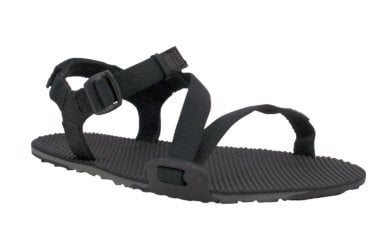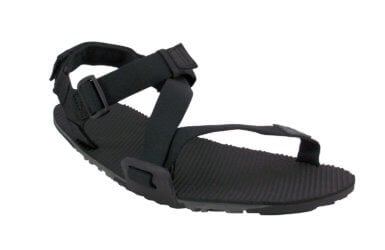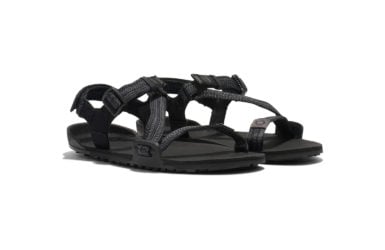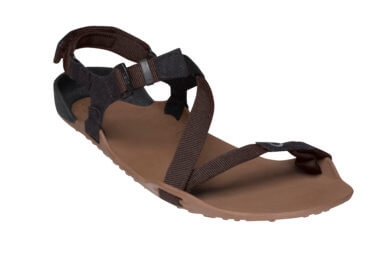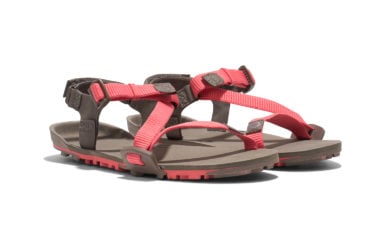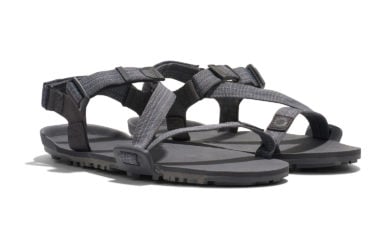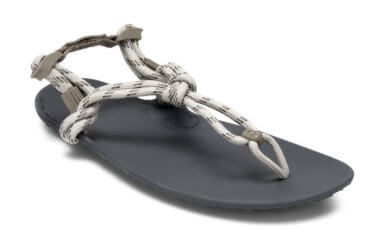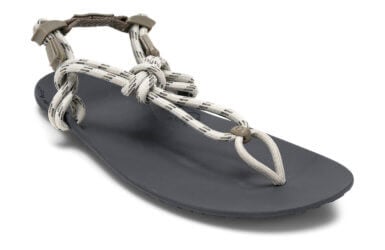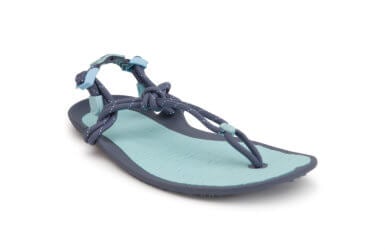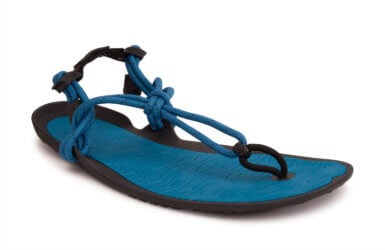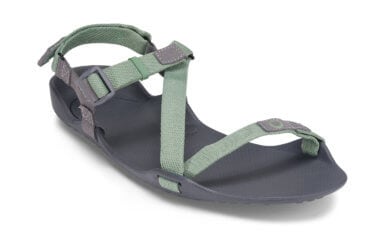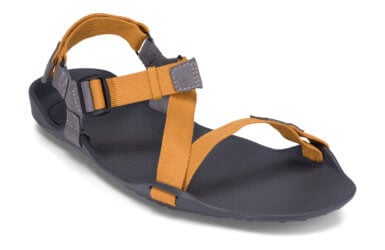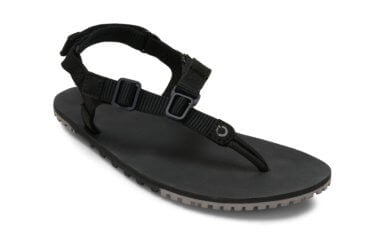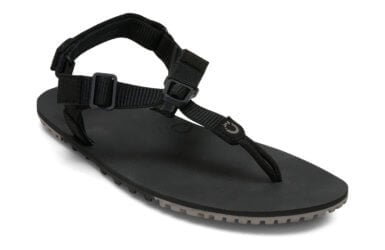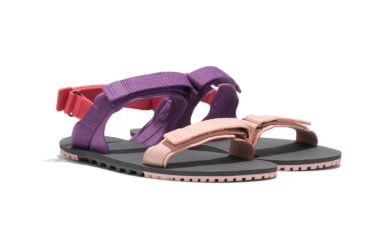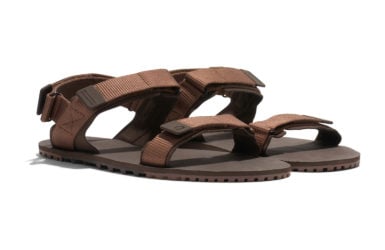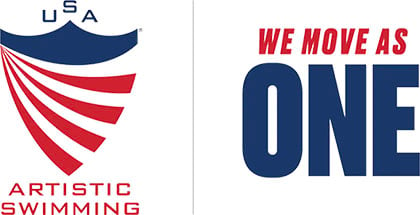People all around the world, and for much of human history have used “barefoot sandals” for almost any activity:
- Walking — casually, around town, or on trails
- Hiking / Camping — or as a camp shoe
- Running — even long distances, like ultra marathons
- Active Recovery — from when you ran in something other than sandals
- Travel — because they’re so lightweight and packable
- Beach, spa, or gym use
- Yoga — it’s like having a yoga mat under your feet at all times
While “barefoot” and “sandals” sound mutually exclusive — you’re either barefoot or you’re not — the term is used for minimalist sandals that let your feet bend, flex, and move as if you were in bare feet, plus give you a layer of protection, and are lightweight.
You can find ready-to-wear styles with both thong and “sport” webbing, or do-it-yourself “DIY” sandal making kits.
Here are the best-selling sandals that will help you Live Life Feet First:
-
Naboso Trail – Women
 FINAL SALESale!
FINAL SALESale!€130.00€39.00View Product -
Naboso Trail – Men
 FINAL SALESale!
FINAL SALESale!€130.00€39.00View Product -
Z-Trail – Kids
 €70.00
View Product
€70.00
View Product -
Z-Trek – Women
 €70.00
View Product
€70.00
View Product -
Z-Trail EV – Women
 FINAL SALE€90.00View Product
FINAL SALE€90.00View Product -
Z-Trail EV – Men
 FINAL SALE€90.00View Product
FINAL SALE€90.00View Product -
Genesis – Women
 FINAL SALE€55.00View Product
FINAL SALE€55.00View Product -
Genesis – Men
 FINAL SALE€55.00View Product
FINAL SALE€55.00View Product -
Aqua Cloud – Women
 €60.00
View Product
€60.00
View Product -
Aqua Cloud – Men
 €60.00
View Product
€60.00
View Product -
Z-Trek – Women
 €70.00
View Product
€70.00
View Product -
Z-Trek – Men
 FINAL SALE€70.00View Product
FINAL SALE€70.00View Product -
H-Trail – Women
 €90.00
View Product
€90.00
View Product -
H-Trail – Men
 €90.00
View Product
€90.00
View Product -
D-Trail – Women
 NEW!€85.00View Product
NEW!€85.00View Product -
D-Trail – Men
 NEW!€85.00View Product
NEW!€85.00View Product
We take your feet and our footwear footwear seriously… but that doesn’t mean we don’t laugh at ourselves. Enjoy some barefoot humor, below.
More entertaining and informative videos on YouTube
Why barefoot sandals are NOT flip flops
Flip flops can be horrible for your feet.
To hold them on your foot, requires an unnatural motion of your toes, and having to “grip” the thong, causing pressure or pain.
A natural movement, bare foot sandal, uses a lacing system that holds the sole onto your foot without needing to grip.
This can eliminate the pressure of the thong. We have thousands of customers who “don’t like things between my toes” who have no issues with our thong style sandals.
Many have even run ultra marathons in their thin, lightweight, flexible sandals.
We’re not saying you HAVE to do this, of course, but it’s nice to know that you can.
And we also make sandals with other lacing styles if you don’t want anything between your toes, as well as sandals with a “toe loop,” and even sandals with an entirely novel lacing system (the Veracruz).
Are these like the sandals in the book "Born To Run"?
Chris McDougall’s wonderful book, Born To Run, introduced many people to the Tarahumara Indians of the Copper Canyon in Mexico.
This tribe — also called the Raramuri, which means “running people” — are known for running ultra long distances in sandals made with used tire scraps for soles, and leather straps to secure them to their feet.
The Tarahumara famously won the highest ultra marathon in the world, the Leadville 100, wearing these sandals, called “huaraches.”
Huarache sandals typically refer to a woven leather sandal from Mexico, but in the running community “huaraches” = “running sandals.”
Xero Shoes’ original DIY sandals were inspired by the Tarahumara. This is one reason we donate a percentage of our sales to support them.
Our sandals are lighter, more flexible, and have different lacing systems that Tarahumara huaraches.
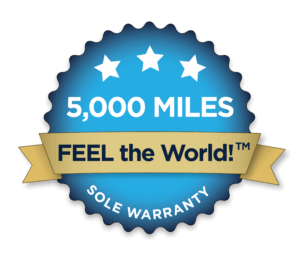
You're helping us create a "MOVEMENT Movement"
Xero Shoes is on a mission: Making natural movement the better, obvious, healthy choice… the way natural food is now.
Have you forgotten the fun you had as a kid on a warm summer day when you’d run outside, kick off your shoes and feel the grass, or the sand, or the water between your toes?
I hope not.
Did you know you can have that feeling NOW, at any age?
If you don’t want to go barefoot, put on some sandals that let your feet do what’s natural and Live Life Feet First!
Men’s Best Selling Barefoot Sandals
Women’s Barefoot Shoes Best Sellers
Kids and DIYs Barefoot Sandal, too!
Still Have Questions About Barefoot Shoes?
Check the Frequently Asked Questions, FAQs, below.
If you still want additional help, reach out to our Customer Happiness Team. You can email them at [email protected].
FAQs
Sandals - Barefoot
When people see a barefoot sandal, they often wonder, “Is it comfortable?”
To answer that, let me first talk about flip-flops, because when people think about barefoot-style sandals they’re often comparing it to their experience with flip-flops, and many people don’t like flip-flops because they don’t like things that go between their toes.
Well, with a barefoot sandal like what you get with Xero Shoes, it’s a different experience because what holds it on your foot is actually the lacing that goes around your ankle.
So unlike a flip-flop where you need to jam your toes into the thong and grip with your toes, something like a huarache from Xero Shoes, you don’t have that same pressure here. We often get emails from people who say, “Oh, I don’t normally like things between my toes, but this doesn’t bother me at all.”
Now, that said, we’ve also got products that don’t have lacing that goes in between your toes, so it’s not a problem if you REALLY don’t want anything between your toes.
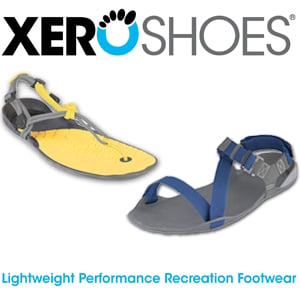
The second thing about comfort is when this lacing system — which, again, is thousands of years old (there are archeological digs that are over 5000 years old with the same kind of lacing pattern) — it can feel like there’s nothing on your foot.
The most common comment we hear from people when we put a pair of Xero Shoes on them and they go for a walk is, “Wow, it feels like there’s nothing there because they’re so light and there’s so much air around your foot!”
Without the stiff thong that you’re used to from a flip-flop, and with the minimal lacing system, it really can feel like nothing. Except this is secure enough to hold on your foot whether you’re taking a walk or going for a run or just hanging out with your friends.
Also, people wonder about the comfort because the soles can be so thin. They say, “What if I step on something or in something?”
Well, you want to use your feet. You want to let the soles of your feet feel things because that’s what they’re designed to do, but you don’t want to feel worried about what you step on or step in, and we give you a number of different options.
Our 4-millimeter do-it-yourself sandal sole — our 4-millimeter Connect sole — is the closest thing to a barefoot experience that you’re going to get. It’s “just enough” protection.
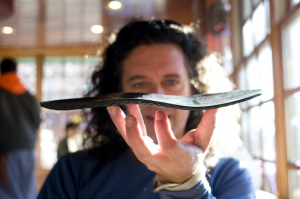
The 5.5mm sole in the Genesis and Jessie also give you great ground feedback with a layer of protection. The Cloud adds a bit of extra cushion on the forefoot.
The 6mm Contact sole in our DIY kits also add a bit more protection.
Or, you can go for the 10-millimeter sole that’s on our Z-Trail sandal. It still gives you a great natural feel because it’s really flexible, but also gives you a level of protection that you think you only get from a sandal that’s this thick and weighs a pound.
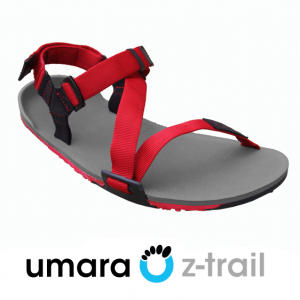
Our favorite thing when people put on the Z-Trail is watching them step on some rocks… their eyes pop out of their heads because they can’t believe how comfortable it is, how they can still feel a little bit of the ground but there’s just none of that pressure point or pointy things that they’re used to from thinner sandals.
You can wear barefoot sandals for almost any activity from taking a walk to a hike, to hanging out on the beach, to chilling with friends, to even running an ultra marathon across Madagascar (I say that last one because we know a couple who did!).
Now, here are some tips about wearing barefoot sandals.
The basic tying method is thousands of years old — the lace comes up between your toes, just goes around your ankle in some way (there are lots of ways), and then comes back to the top of your foot and you tie it in place.
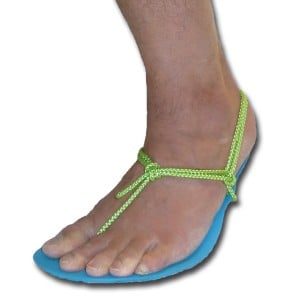
You can do this with a single lace or you can do it with multiple laces. With our sandals, we’ve developed a design with two laces that makes it really, really simple and fast to adjust the tension and get a good fit.
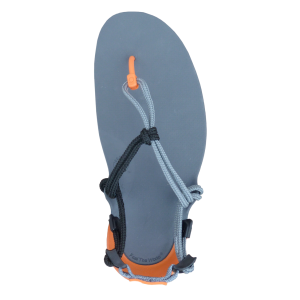
Here something you want to think about when finding the right fit: You want to go for snug but comfortable tension of the laces around your foot.
So you don’t want it too tight, you don’t want it too loose.
Lena, my wife and partner in Xero Shoes, likes to say there’s a sweet spot for tension, and some people find it right away and some people need to experiment a couple of times for a few days until they find that sweet spot.
But once you do, you know what it feels like and you can recreate it instantly. And in fact, the more experience you have wearing barefoot sandals, the less picky you get about the tension. The more comfortable you get using this kind of a product, the more flexibility you have.
You can wear them a little looser and it’s not a problem, a little tighter and it’s not a problem, but at first you want to make sure you’re going for something comfortable.
In a huarache-style tying, there’s a knot at the top of your foot. You can move that down, you can move it up… so you can get it closer to your ankle or closer to your toes.
We like to keep it kind of at the two-thirds spot between your toes and your ankle. When you do that, that gives you the best combination of comfort and security. If you move the knot closer to your ankle, things might feel a little more loose across your toes. If you move it closer to your toes, it might feel a little too flexible around your ankle.
As the laces come around your heel, again you want to go for snug but comfortable. You want to find the tension that holds it on comfortably but not too tight.
Now, if your Achilles doesn’t have a big divot in it, if you have sort of a flat spot from your heel into your calf, you might want to raise the laces where they move through the sandal sole by wrapping the lace around itself at the ankle hole. When you do this, you have less of an angle in the lace from your ankle to your heel, and that will work better in your case.
So that should get you started. If you have any other questions, you can find answers on our website, and feel free to drop us an email or give us a call. We’re always happy to help.
Christopher McDougall’s best-seller, Born To Run, introduced many people to the Tarahumara Indians, a tribe in Mexico’s Copper Canyon, who run long distances in huarache running sandals.
Technically, “huarache” is just a woven leather sandal from Mexico, or just any type of sandal.
The running sandals of the Tarahumara are made with a scrap of used auto tire for the tread, usually a leather footbed, and a leather thong strap that’s wrapped around the ankle to secure it to the foot.
Practically, any sandal that allows you to run is a running sandal.
What most people think of when they think “running sandals,” though, is NOT a flip flop, and NOT a heavy sport sandal, like a Chaco, Teva, or Keen sandal.
Most people equate “running sandals” with “barefoot sandals.”
That is, something that gives you some protection for your sole, and some way to hold that onto your foot… just like the sandals humans have been wearing for thousands of years.
The Xero Shoes sandals that most people use for running include:
- Genesis
- Cloud
- Z-Trek
- Z-Trail
One of the fun things about making your own sandals is all the ways you can decorate them.
There’s lots of different jewelry that you can add, starting with something really simple like a dolphin charm or a Celtic knot pendant… something you can find at craft or hobby stores. You just lace them into the sandal’s strap.
You can add some beads by threading them onto the lace.
We have one customer who painted each of her toenails a different color, to match the multi-colored beads she threaded onto her sandal’s laces.
People have also used shells, dried starfish, pearls, Swarovski crystal, pretty much anything that can hang on a lace or be threaded onto one.
What else? Just have fun. Use flowers, or anything else can think of.
The whole idea is that you want to express your personality with your sandal and the way you’re going to do it is by either lacing things into the lacing pattern, so the cord is going through the beads, or snapping things around the lace.
The beads from Pandora bracelets – those fit perfectly around our laces.
Again, the most important part: Have fun, decorate, express yourself. We can’t wait to see see what you come up with.
This depends on whether you want a ready-to-wear sandal, or if you want to have fun making your own huarache-style sandals for running, walking, hiking, or anything else you do.
One of the best things about using our do-it-yourself sandal-making kits is no matter what size or shape your foot is, you can make a barefoot sandal that perfectly fits your foot.
The reason is that we have templates that range in sizes from really tiny to really, really large. So you buy the template that’s closest to your foot shape. If you have a really wide foot, you buy one that just matches the width, and you don’t worry about the length because you simply trim the sole’s length to perfectly fit your foot shape. You get a shoe that’s made just for you… by you.
If you’re not a “make your own sandals” kind of person, and want to buy our ready-to-wear sandals, here’s what you do:
- Go to our “template page“
- Follow the instructions to measure your feet
- Print the template that matches your foot length (make sure it prints at the correct scale… we have a ruler printed on the template to compare to a real ruler so you can make sure)
- Step on the template
- If the size of that sandal template is too big, print the smaller one. And, of course, vice versa.
- For the Z-Trek, Z-Trail, Naboso, and Veracruz sandals, if you’re a man and the template seems too wide, try the “women’s” template. And if you’re a woman and the woman’s sandal template seems too narrow, try the “men’s” instead.
- If you’re really not sure, take a few pictures of your feet on the templates and email them to us. We’ll give you our opinion on optimal sizing.
Once people get into the fun and benefits of barefoot sandals for themselves, they often want to share that with other people, especially and including their children.
So we get emails and phone calls every day from people saying, “I got a baby boy and I don’t want to put him in shoes,” or, “I have a new infant,” “I have a newborn,” “I’ve got toddlers.” “We love the idea that they use their feet naturally but we want to give them the protection that a sandal can offer. What do we do?”
At Xero Shoes, have a “sport sandal” for kids, a children’s version of our best-selling Z-Trail sandal.
Another option, one that thousands have done, is to take one of our do-it-yourself sandal-making kits and use that for kids. We’ve done it with toddlers. We’ve done it with infants. We’ve done it with newborns. We’ve done it with kids of almost any age and almost any size.
Here’s me, Steven, lacing up one of our kits for a baby 😉
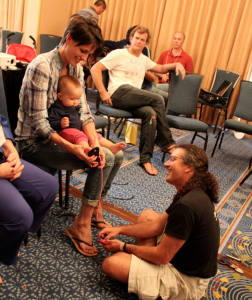
The one thing I’ll tell you is most babies and infants don’t really need foot protection.
They’re not putting a lot of force into the ground. They’re not going to get into a situation that’s really dangerous. So you want to leave them as natural as you can, as long as you can. But when you want to give just the barest amount of protection so that you feel better, so that you’re confident, so that you know that they’re not going to worry about what they’re stepping on or stepping in, our 4-millimeter Connect sole is the closest thing you’re going to get to barefoot with a layer of protection.
The one suggestion that I’ll make for making sandals for kids, and toddlers in particular, is that any part of the lace that is underneath the sole and that comes in contact with the ground… cover that with a little bit of flexible epoxy like Shoe Goo. And cover the top bit of the lace that comes above the shoe right where it goes in between their toes, too.
Any place that they could be creating friction… give it a little extra support with a little bit of epoxy or Shoe Goo. Because kids tend to add way more force than we can imagine as they’re running and jumping and playing around, and this treatment will make their shoes last a whole lot longer.
Almost every day we get an email from someone saying, “I’m having a wedding and I want to be barefoot… but not barefoot,” or “I want to have barefoot sandals for myself as the bride, or for my bridesmaids, or for all of us,” or, “We’re having a wedding on the beach and shoes just don’t seem appropriate. Sandals seem appropriate but we want something that looks cute, something that’s fun, something we can decorate.”
Maybe it’s going to turn into a bridal shower event or a wedding party event where people make their own sandals and decorate them themselves so there’s a theme of barefoot sandals, but each person has their own unique flavor.
Outfitting a wedding party is easy to do, and whether you have a DIY party or everyone gets ready to wear sandals, it’s a lot of fun. If you’re having a wedding party and you want to have Xero Shoes for everybody in the party, give us a shout, drop us an email, and we’ll help you make that happen.
We want to see pictures because if we know you’re going to have a lot of fun, then we want to share that with everyone else!
When people think sandals, they often think “beach” or “summer.”
We’ve had lots and lots of people who have worn Xero Shoes at the beach. Sometimes they’re using Xeros for walking around, when they don’t want to step on debris (natural or otherwise), or the sand is too hot for bare feet.
And sometimes they’re at a beach wedding and want sandals. We often get calls from the bride-to-be saying that she wants to have a party with all of her bridesmaids where everyone makes their own sandals, or they take our ready-to-wear sandals and decorate them with beads and charms and pendants so they have something really, really fun to wear and still have that open natural feeling that goes along with being at the beach.
The other thing people use these for at a beach is paddleboarding or surfing… whether they’ll wear Xero Shoes on the boards or just when they’re done. We have lots of people who do both of those as well.
Some people don’t like the heat that they get from the sand, and the good news with a barefoot sandal is you get some protection from that heat.
Now, if you’re using one of our really thin soles, you can’t argue with physics — heat will travel through a sole eventually.
So if you’re standing on something really, really hot for a long time, it’s going to get warm — there’s no way to prevent around that. But you can also use one of our thicker soles. The sole on our Z-Trail sandal that has three layers – our FeelTrue rubber layer, our TrailFoam layer, and our BareFoam layer. And because of those three layers, there’s more protection from heat, and protection from abrasion as well.
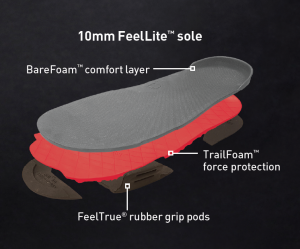
One other thought about Xero Shoes at the beach: people will ask, “Hey, are they safe in the ocean or safe in a swimming pool?” and they’ll also ask, “Will I get sand underneath my foot?”
Well, it is an open sandal, so there’s no way to protect you from keeping things from getting underneath your foot because it’s an open sandal.
The good news though is that all you have to do to get sand out of the sandal is just either flick the sandal and it’ll come out or just stick your feet in the water.
And the good news about the “stick your feet in water solution” is that our Xero Shoes FeelTrue® soles are made so that they’re won’t be damaged from saltwater or from chlorine.
So jump in the ocean, jump in a pool, wash off your feet, and go back to having fun.
As we always say about Xero Shoes… we want you to Feel The Freedom. Feel the Fun. Feel the World!
Naboso Technology was developed by Dr. Emily Splichal, a surgical podiatrist in New York.
It’s made to stimulate the mechanoreceptors in the sole of your foot to give more information to your brain about how your foot is helping you balance and move.
We sell Naboso proprioceptive insoles on our site.
We then developed the Naboso Trail sandal — combining our best-selling Z-Trail sandal with a Naboso material on the footbed.
Check out the reviews to see if you’d like to wear the Naboso Trail and Live Life Feet First!
Not surprisingly, one place is here on our website.
Thanks to the magic of the Internet, you can now get barefoot sandals pretty much anywhere that you live.
We have customers in 97 countries, including Australia, Canada, all of Europe, Manila in the Philippines, Estonia… you name it.
In fact, one of the first pairs that we sold — and we started our company in the winter — was to someone in Toronto, Ontario, Canada. In the middle of winter! Maybe they were for a vacation 😉
We have a list of stores at XeroShoes.com/stores, and of course you can look on eBay, on Amazon, eBags, and other online stores.
So if you want to wear barefoot Xero Shoes — either the “barefoot” kind or the “sandal” kind, you’re not going to have a hard time finding them.
There are lots of places that sell barefoot-style sandals now:
-
- Company stores like ours
- Physical stores that carry our products
- Amazon.com
- eBay
- eBags
- Craft and hobby stores for the decorative “barefoot” sandals
It should be pretty easy for you to find what you want.
If you go www.XeroShoes.com/stores, you’ll find a list of websites and physical stores that sell both our do-it-yourself sandal-making kits as well as our ready-to-wear sandals that give you that great barefoot, natural movement feeling.



